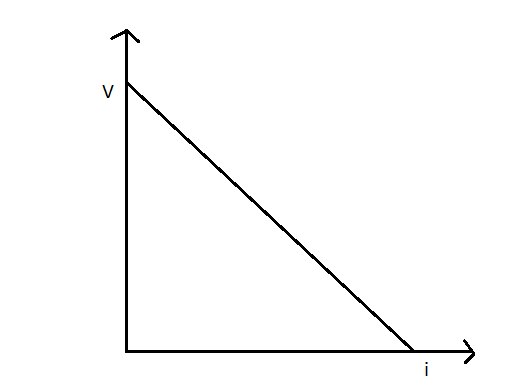
Answer
474.9k+ views
HINT- We have to apply basic formulae to calculate emf E and internal resistance r. formulae used in this question are as follows- V = E-ir and i = $\dfrac{E}{{R + r}}$, where V is the voltage, E is the emf, R is the load resistance and r is the internal resistance. Also using the above relation we can draw our required graphs.
V vs i-

V vs R-

Now from the question, we have
Terminal voltage (V) = E – ir ………(1)
The current is given by i = $\dfrac{E}{{R + r}}$
Substituting value of i in equation (1), we get
Now, $V = E - \dfrac{{Er}}{{(R + r)}} = \dfrac{{ER}}{{R + r}} = \dfrac{E}{{(1 + \dfrac{r}{R})}}$……….(2)
According to equation (1) and (2), the graph V vs i and V vs R is shown in the following figure.
As, R=4$\Omega $ and i= 1A we have, $i = \dfrac{E}{{R + r}}$, so$1 = \dfrac{E}{{4 + r}}$ or $E = (4 + r)$…….(3)
When R=9$\Omega $ and i=0.5A we have, $i = \dfrac{E}{{9 + r}} or 2E = 9 + r$……..(4)
Equating (3) and (4), we have
2(4+r) = 9+r or r = 1$\Omega $
Thus, E = 4+r = 4+1 = 5V
Hence, we get emf E = 5V and internal resistance r = 1$\Omega $
NOTE- Basic definition of emf and internal resistance.
emf- it can be defined around a closed loop of conductor as the electromagnetic work that would be done on an electric charge if it travels once around the loop.
Internal resistance- internal resistance refers to the opposition to the flow of current offered by the cells and batteries themselves resulting in the generation of heat. Internal resistance is measured in ohms.
The emf of a cell is always greater than the potential difference across the cell.
V vs i-

V vs R-

Now from the question, we have
Terminal voltage (V) = E – ir ………(1)
The current is given by i = $\dfrac{E}{{R + r}}$
Substituting value of i in equation (1), we get
Now, $V = E - \dfrac{{Er}}{{(R + r)}} = \dfrac{{ER}}{{R + r}} = \dfrac{E}{{(1 + \dfrac{r}{R})}}$……….(2)
According to equation (1) and (2), the graph V vs i and V vs R is shown in the following figure.
As, R=4$\Omega $ and i= 1A we have, $i = \dfrac{E}{{R + r}}$, so$1 = \dfrac{E}{{4 + r}}$ or $E = (4 + r)$…….(3)
When R=9$\Omega $ and i=0.5A we have, $i = \dfrac{E}{{9 + r}} or 2E = 9 + r$……..(4)
Equating (3) and (4), we have
2(4+r) = 9+r or r = 1$\Omega $
Thus, E = 4+r = 4+1 = 5V
Hence, we get emf E = 5V and internal resistance r = 1$\Omega $
NOTE- Basic definition of emf and internal resistance.
emf- it can be defined around a closed loop of conductor as the electromagnetic work that would be done on an electric charge if it travels once around the loop.
Internal resistance- internal resistance refers to the opposition to the flow of current offered by the cells and batteries themselves resulting in the generation of heat. Internal resistance is measured in ohms.
The emf of a cell is always greater than the potential difference across the cell.
Recently Updated Pages
Fill in the blanks with suitable prepositions Break class 10 english CBSE

Fill in the blanks with suitable articles Tribune is class 10 english CBSE

Rearrange the following words and phrases to form a class 10 english CBSE

Select the opposite of the given word Permit aGive class 10 english CBSE

Fill in the blank with the most appropriate option class 10 english CBSE

Some places have oneline notices Which option is a class 10 english CBSE

Trending doubts
Fill the blanks with the suitable prepositions 1 The class 9 english CBSE

How do you graph the function fx 4x class 9 maths CBSE

When was Karauli Praja Mandal established 11934 21936 class 10 social science CBSE

Which are the Top 10 Largest Countries of the World?

What is the definite integral of zero a constant b class 12 maths CBSE

Why is steel more elastic than rubber class 11 physics CBSE

Distinguish between the following Ferrous and nonferrous class 9 social science CBSE

The Equation xxx + 2 is Satisfied when x is Equal to Class 10 Maths

Differentiate between homogeneous and heterogeneous class 12 chemistry CBSE




